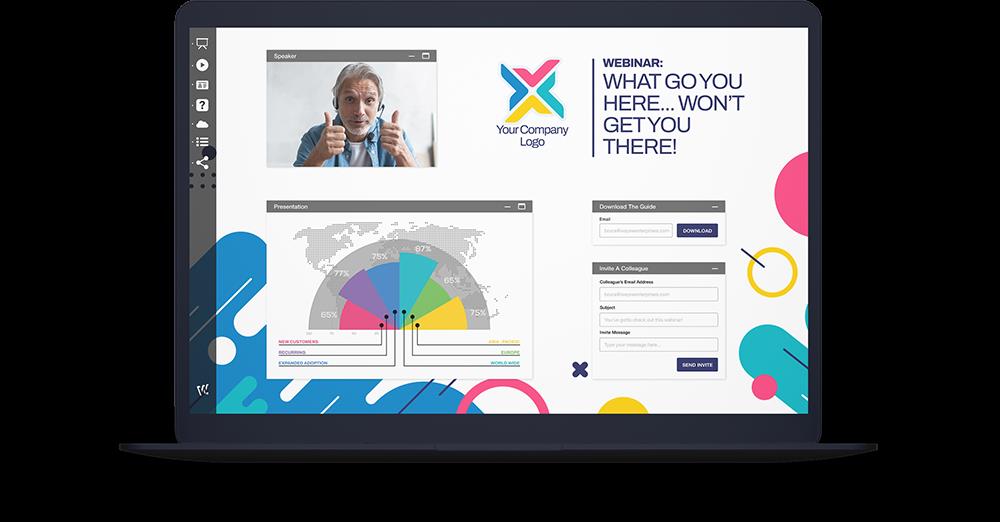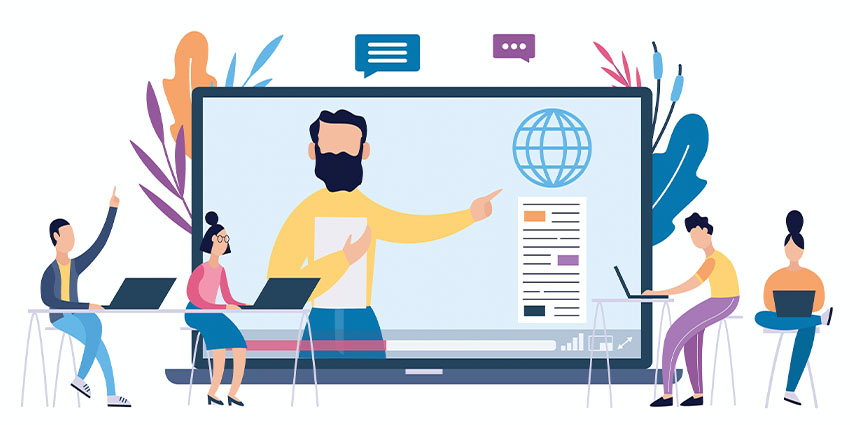
In the rapidly evolving landscape of education, the virtual classroom has emerged as a powerful tool for delivering effective online courses. However, creating an engaging and interactive learning experience requires the right set of tools.
In this article, we will explore the top 10 tools that can help educators master the virtual classroom. From video conferencing platforms to virtual reality tools, these resources empower educators to create dynamic and impactful online courses.
Join us as we uncover the key to unlocking the full potential of the digital learning environment.
One of the most popular video conferencing platforms currently used by businesses is Zoom, which allows up to 100 participants to join a meeting at once.
Video conferencing has become an essential tool for businesses, offering numerous benefits. Firstly, it enables remote collaboration, allowing teams to connect regardless of their physical location. This increases productivity and efficiency as employees can work together seamlessly.
Secondly, video conferencing reduces travel costs and saves time, as individuals can attend meetings from the comfort of their own workspace.

To ensure successful virtual meetings, it is important to follow a few key tips. Firstly, make sure to have a stable internet connection to avoid disruptions. Secondly, dress professionally and choose an appropriate background. Lastly, engage actively by using features like screen sharing and chat functions.
Learning Management Systems
Several organizations are adopting learning management systems (LMS) to streamline and enhance their training processes. LMS is a software application that enables the creation, delivery, and management of educational content. It provides a centralized platform for instructors and students to access course materials, participate in discussions, and track progress.
To make online learning more engaging and interactive, virtual whiteboard software is often integrated into LMS. This tool allows instructors to present information visually, collaborate with students in real-time, and facilitate discussions.
The combination of LMS and virtual whiteboard software offers a dynamic learning environment that promotes student engagement, collaboration, and knowledge retention. With the increasing demand for flexible and accessible education, learning management systems and virtual whiteboard software are becoming essential tools for effective online courses.
Interactive Content Creation Tools
Interactive content creation tools are essential for educators looking to enhance their online courses with engaging multimedia options and dynamic interactive learning experiences. These tools allow instructors to create interactive quizzes, presentations, videos, and simulations, enabling students to actively participate in their learning and deepening their understanding of the material.
How can we effectively use engaging multimedia options to enhance the learning experience in online courses?
The use of multimedia in online courses can greatly enhance the learning experience by providing visual and interactive content that keeps students engaged and helps them retain information. Here are four strategies for effectively incorporating engaging multimedia options in online courses:

Video lectures: By incorporating video lectures, instructors can present information in a dynamic and engaging way, making it easier for students to understand complex concepts.
Interactive simulations: Simulations allow students to actively participate in the learning process by providing real-life scenarios where they can practice and apply their knowledge.
Gamification strategies: Gamifying the learning experience can increase student motivation and engagement. Incorporating game elements such as leaderboards, badges, and rewards can make the learning process more enjoyable and interactive.
Multimedia assignments: Providing multimedia assignments, such as creating videos or podcasts, allows students to showcase their understanding of the course material in a creative and interactive way.
Dynamic Interactive Learning Experiences
In order to create dynamic interactive learning experiences, instructors can utilize a variety of content creation tools that enable students to actively engage with the course material.
These tools not only enhance student understanding but also promote critical thinking and problem-solving skills.
One such tool is interactive videos, which allow students to interact with the content by answering questions or making choices that affect the outcome.

Another effective technique is gamification, where instructors can create games or quizzes that make learning fun and engaging.
Virtual reality (VR) is also gaining popularity in education, as it provides immersive experiences that allow students to explore different environments and scenarios.
Virtual Whiteboard Software
Frequently utilized by educators and professionals alike, virtual whiteboard software offers a dynamic and collaborative platform for interactive brainstorming and idea sharing. With the ability to create, edit, and share ideas in real-time, virtual whiteboard collaboration has become an essential tool for remote teams and online classrooms.
Here are four key benefits of using virtual whiteboard software:
Enhanced collaboration: Virtual whiteboards allow multiple users to work together simultaneously, fostering teamwork and creativity.
Visual representation: By using virtual whiteboards, ideas can be visually represented through diagrams, charts, and drawings, making complex concepts easier to understand.
Flexibility and accessibility: Virtual whiteboard software can be accessed from anywhere with an internet connection, providing freedom and flexibility for users.

Easy organization and storage: Virtual whiteboards offer the convenience of saving and organizing ideas digitally, eliminating the need for physical storage and reducing clutter.
Online assessment tools have become essential in the virtual classroom. They allow educators to provide timely feedback and engage students in interactive assessment options. These tools streamline the grading process and offer a range of question types, such as multiple choice, short answer, and even interactive quizzes and games.
Importance of Feedback
The article highlights the significance of soliciting feedback from students to enhance the efficacy of online assessment tools. Feedback plays a crucial role in effective online learning, as it allows instructors to understand the needs and preferences of their students. By actively seeking feedback, educators can make necessary adjustments to their online courses and assessments, ensuring that they are engaging and effective.
Here are four key reasons why feedback is important in online learning:
Personalization: Feedback allows instructors to tailor their teaching methods and materials to meet the individual needs of students, promoting a more personalized learning experience.
Improvement: Feedback helps students identify areas where they need to improve, enabling them to take proactive steps towards their own learning and development.
Engagement: By incorporating feedback, instructors can create a more interactive and engaging online learning environment, encouraging active participation from students.

Motivation: Feedback provides students with a sense of accomplishment and motivation, boosting their confidence and encouraging them to continue their learning journey.
Interactive Assessment Options
One effective way to engage students and gather valuable data in the virtual classroom is through the use of interactive assessment options, such as through gamification or collaborative activities.
Interactive quizzes provide students with the opportunity to actively participate in their learning process by answering questions, solving problems, and receiving immediate feedback. This not only keeps students engaged but also allows them to track their progress and identify areas for improvement.
Real-time feedback is another key feature of interactive assessment options, which enables instructors to provide timely guidance and support to students. By leveraging technology, educators can create interactive quizzes that are visually appealing and interactive, making the learning experience more enjoyable and effective.
Furthermore, collaborative activities foster teamwork and critical thinking skills, as students work together to solve problems and achieve common goals.
Overall, incorporating interactive assessment options in the virtual classroom enhances student engagement, promotes active learning, and provides valuable data for instructors to assess student performance.
Collaboration and Communication Apps
To enhance productivity and streamline communication, educators can utilize a variety of collaboration and communication apps designed to foster engagement and facilitate seamless interaction among students in the virtual classroom. These tools not only bridge the physical distance between students and teachers but also create a sense of community and collaboration in the online learning environment.

Here are the top 10 collaboration and communication apps that can revolutionize the way educators and students connect and work together:
Google Classroom: A comprehensive platform for sharing assignments, providing feedback, and facilitating discussions.
Microsoft Teams: An all-in-one collaboration tool that integrates messaging, video conferencing, and file sharing.
Slack: A popular communication platform that allows for real-time messaging, file sharing, and collaboration.
Zoom: A widely used video conferencing tool with features like breakout rooms and screen sharing.
These apps empower educators to create an engaging and interactive virtual classroom, ensuring that students have the freedom to collaborate and communicate effectively.
Screen recording and sharing tools have become essential for creating effective online courses. By utilizing these tools, instructors can easily capture their computer screens, creating engaging video tutorials and demonstrations.

Popular tools such as Screencast-O-Matic and Camtasia offer a range of features to enhance the learning experience, from editing capabilities to interactive quizzes.
Benefits of Screen Recording
Several advantages arise from utilizing screen recording as a tool for enhancing online course delivery and engagement. Screen recording allows for asynchronous learning, providing flexibility for students to access course materials at their convenience.
Here are four key benefits of screen recording in online education:
Enhanced Content Delivery: Screen recording allows instructors to create engaging video content that can be accessed and reviewed by students multiple times, promoting a deeper understanding of the material.
Visual Demonstrations: Screen recording enables instructors to visually demonstrate complex concepts, making it easier for students to grasp and apply the knowledge.
Personalized Feedback: With screen recording, instructors can provide personalized feedback to students by recording their evaluations or comments, creating a more interactive and personalized learning experience.
Accessibility and Inclusion: Screen recording ensures that course materials are accessible to all students, including those with disabilities or learning differences, promoting inclusivity in online education.

Overall, screen recording empowers both instructors and students by enhancing the delivery of online courses and fostering engagement and understanding.
One popular option for sharing screens during online presentations is a tool that allows users to record and share their screens with others, providing an interactive and collaborative learning experience. Screen sharing has become an essential tool for educators and professionals alike, as it allows for seamless communication and the ability to showcase information in real time.
Screen sharing offers numerous benefits, such as the ability to visually demonstrate concepts and ideas, engage participants through interactive discussions, and provide a platform for collaborative learning. By sharing their screens, presenters can walk participants through step-by-step processes, highlight important information, and address any questions or concerns in real time.
To make the most of screen sharing, here are a few tips to keep in mind. First, ensure that your screen is clutter-free and organized to avoid distractions. Second, practice beforehand to familiarize yourself with the screen sharing tool and ensure smooth navigation. Lastly, be mindful of your audience's attention span and use visuals and interactive elements to keep them engaged.
Tips for Effective Sharing
To optimize the sharing experience, it is crucial to familiarize oneself with the various screen recording and sharing tools available and select the most suitable one. Here are four top tips for effective sharing:
Choose the right tool: Research and compare different screen recording and sharing tools to find the one that best suits your needs. Consider factors such as ease of use, compatibility, and features like annotation and live commenting.
Plan your content: Before sharing your screen, make sure to organize your content in a logical and engaging manner. Structure your presentation or demonstration in a way that captures your audience's attention and keeps them interested throughout.

Use interactive discussion techniques: Encourage active participation from your audience by incorporating interactive elements into your screen sharing session. Use features like polls, quizzes, and breakout rooms to foster engagement and facilitate meaningful discussions.
Provide clear instructions: Clearly communicate to your audience how they can actively engage and participate during the screen sharing session. Use prompts, questions, and chat features to encourage feedback, questions, and collaboration.
In the realm of educational technology, educators are increasingly turning to gamification platforms as a means of enhancing student engagement and motivation. Gamification techniques involve incorporating game elements, such as competition, rewards, and challenges, into the learning process. By introducing these elements, educators can create a more interactive and enjoyable learning experience for students.
Engagement strategies play a crucial role in fostering student motivation and active participation. Gamification platforms offer various tools and features that allow educators to implement these strategies effectively. For example, they can use leaderboards to encourage friendly competition among students, badges to reward achievements and progress, and quests or missions to provide a sense of purpose and direction.
Course Analytics and Reporting Software
Course analytics and reporting software provides educators with valuable insights into student performance and progress throughout the online learning journey. This powerful tool enables teachers to track and analyze various metrics, such as course completion rates and student engagement levels.
By utilizing course analytics and reporting software, educators can make data-driven decisions to improve their teaching strategies and enhance student outcomes. Here are four key benefits of using course analytics and reporting software:
Enhanced student engagement: By tracking student interactions, educators can identify areas where students may be disengaged and take proactive measures to increase engagement.

Personalized learning: Course analytics software allows educators to identify individual student needs and tailor instructional materials and activities accordingly.
Early intervention: By monitoring student progress in real-time, educators can identify struggling students early on and provide timely support and intervention.
Performance evaluation: Course analytics and reporting software enables educators to assess student performance and identify areas of improvement for future courses.
The use of virtual reality and augmented reality tools is revolutionizing the way educators engage and immerse students in virtual learning experiences. These innovative technologies offer new possibilities for interactive and immersive learning, allowing students to explore virtual environments and simulations that enhance their understanding and retention of knowledge.
Virtual reality training provides a simulated environment that replicates real-world scenarios, enabling students to practice and develop skills without the need for physical resources or risks associated with certain activities. Whether it's medical students performing virtual surgeries or engineers learning to operate complex machinery, virtual reality training offers a safe and cost-effective way to enhance practical learning.
On the other hand, augmented reality simulations overlay digital information onto the real world, creating interactive experiences that blend virtual and physical elements. This technology allows students to visualize abstract concepts, manipulate virtual objects, and engage in collaborative problem-solving activities.
Frequently Asked Questions
Popular video conferencing platforms used in virtual classrooms include Zoom, Microsoft Teams, and Google Meet. These platforms offer benefits such as real-time communication, screen sharing, and interactive features, enhancing the effectiveness of online courses.

How Can Learning Management Systems Help Instructors Track and Assess Student Progress in an Online Course?
Learning management systems (LMS) play a crucial role in tracking and assessing student progress in online courses. Through learning analytics, instructors can monitor student engagement, identify areas of improvement, and provide personalized feedback, enhancing the overall learning experience.
Are There Any Interactive Content Creation Tools That Allow for Real-Time Collaboration Between Students and Instructors?
Yes, there are interactive content creation tools available that facilitate real-time collaboration between students and instructors. These tools, such as interactive learning platforms, enable seamless communication and engagement, enhancing the overall online learning experience.
What Are Some Virtual Whiteboard Software Options That Offer Features Like Drawing, Annotating, and Sharing Files?
Virtual whiteboard software comparison: There are several options available for online collaboration, offering features like drawing, annotating, and sharing files. These tools facilitate real-time interaction and enhance the virtual classroom experience for both students and instructors.
There are several automated assessment tools available that provide online grading and feedback to students. These tools streamline the assessment process, saving time for educators and providing immediate feedback to enhance student learning.
 Network marketingWork from home jobsEntrepreneurshipAffiliate marketingFinancial freedomPrivacy PolicyTerms And Conditions
Network marketingWork from home jobsEntrepreneurshipAffiliate marketingFinancial freedomPrivacy PolicyTerms And Conditions
